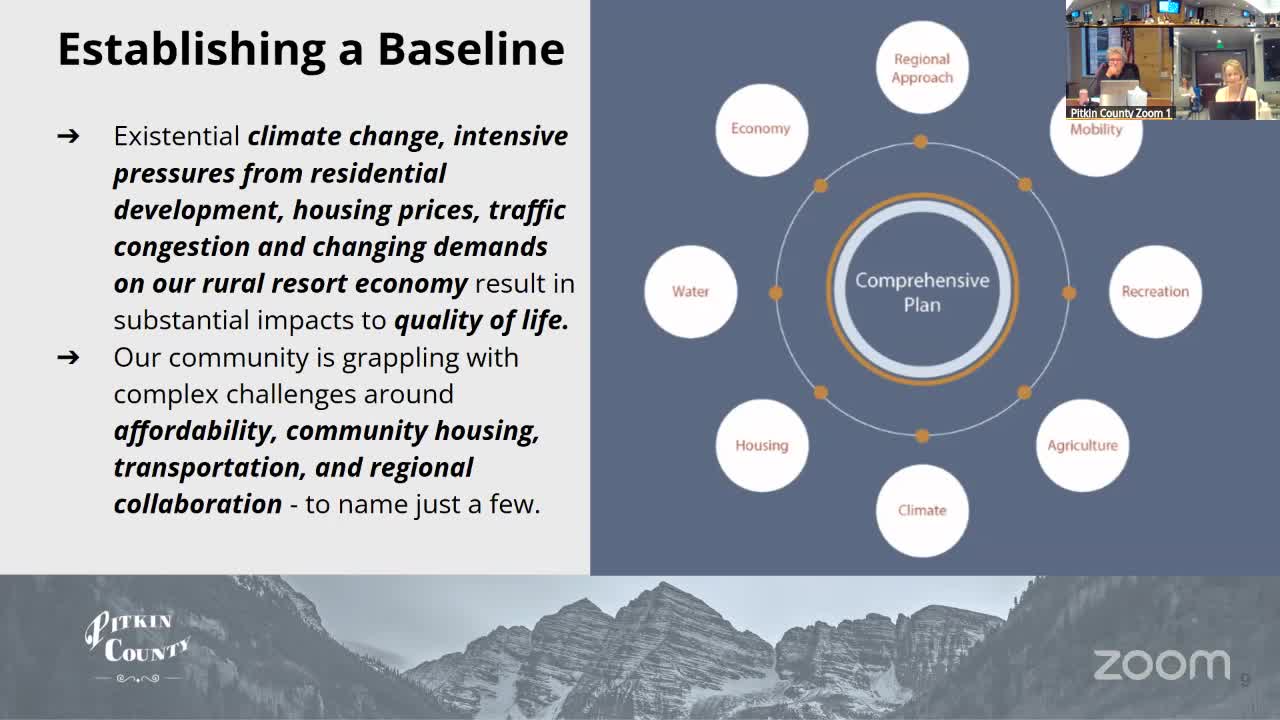Peking County prioritizes natural environment in comprehensive growth plan
August 29, 2025 | Pitkin County, Colorado
This article was created by AI summarizing key points discussed. AI makes mistakes, so for full details and context, please refer to the video of the full meeting. Please report any errors so we can fix them. Report an error »

In a recent special meeting of the Planning and Zoning Commission in Pitkin County, Colorado, officials discussed the critical balance between community development and environmental sustainability. The meeting highlighted the ongoing efforts to establish a comprehensive plan that addresses various pressures facing the community, including climate change, residential development, affordability, and traffic, all of which significantly impact the quality of life for residents.
The discussion centered around the findings of the Community Growth Advisory Committee (CGAC), which emphasized the need for a baseline understanding of current conditions in the county. This baseline will inform future policy directions, ensuring that growth aligns with the community's values and environmental goals. The comprehensive plan aims to address key issues such as water management, economic development, mobility, and recreation, all while prioritizing the preservation of the natural environment.
One of the main takeaways from the meeting was the recognition of the impact of large homes and increased activity in rural areas, which may not be suitable for such development. The officials acknowledged the misalignment between existing infrastructure and the areas experiencing growth, stressing the importance of using the land use code as a primary tool to manage these challenges effectively.
The meeting also underscored the county's commitment to conserving public lands and protecting natural habitats through robust conservation easements and open space programs. This commitment is seen as foundational to the community's identity and future planning efforts. The officials reiterated that the natural environment must be prioritized, serving as a guiding principle in balancing development pressures with the need for environmental sustainability and rural preservation.
As Pitkin County moves forward with its comprehensive plan, the discussions from this meeting will play a crucial role in shaping policies that reflect the community's values and address the pressing challenges it faces. The next steps will involve further refining these policies to ensure they effectively support both growth and environmental stewardship.
The discussion centered around the findings of the Community Growth Advisory Committee (CGAC), which emphasized the need for a baseline understanding of current conditions in the county. This baseline will inform future policy directions, ensuring that growth aligns with the community's values and environmental goals. The comprehensive plan aims to address key issues such as water management, economic development, mobility, and recreation, all while prioritizing the preservation of the natural environment.
One of the main takeaways from the meeting was the recognition of the impact of large homes and increased activity in rural areas, which may not be suitable for such development. The officials acknowledged the misalignment between existing infrastructure and the areas experiencing growth, stressing the importance of using the land use code as a primary tool to manage these challenges effectively.
The meeting also underscored the county's commitment to conserving public lands and protecting natural habitats through robust conservation easements and open space programs. This commitment is seen as foundational to the community's identity and future planning efforts. The officials reiterated that the natural environment must be prioritized, serving as a guiding principle in balancing development pressures with the need for environmental sustainability and rural preservation.
As Pitkin County moves forward with its comprehensive plan, the discussions from this meeting will play a crucial role in shaping policies that reflect the community's values and address the pressing challenges it faces. The next steps will involve further refining these policies to ensure they effectively support both growth and environmental stewardship.
View full meeting
This article is based on a recent meeting—watch the full video and explore the complete transcript for deeper insights into the discussion.
View full meeting
